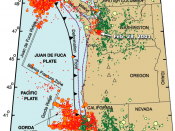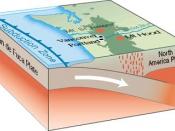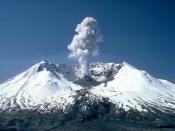The Role of Plate Tectonics
In Natural Disasters on the West Coast
On March 27, 1964 an earthquake shook Anchorage Alaska. It was 5:36 P.M. local time. The quake registered 8.6 on the Richter scale, although scientists now favor a different magnitude scale for very lage quakes that shows it at 9.2. This made it the largest quake that has hit the United States in recorded history, and second largest known worldwide. The earthquake started with a few seconds of small tremors. The tremors quickly developed into intense shaking that knocked people down, threw objects off shelves and caused buildings to collapse. Amazingly this shaking lasted for a full five minutes. People reported that it seemed like an eternity. The time of shaking generally increases with greater magnitude. The longer the ground shakes, the more damage will occur as structures first weaken and then collapse under the strain.
The long period of shaking doubtless caused much of the ground failure that was observed from this quake. The widespread geological damage was impressive. Large areas were lifted up or dropped by several feet. Cliffs collapsed in huge landslides, avalanches also occured.1
It is estimated that 131 people were killed in the quake. This is considerably lighter than might be expected for a disaster of the magnitude. This relatively low number can be attributed to the sparse population of the area and the fact that the quake occurred when most people were at home. The physical damage fared worse than the death toll. Downtown Anchorage was especially hard hit. Building facades crashed into the street. In some places one side of the street dropped down over 10 feet, leaving the facing building towering above. In places ground waves of over 3 feet high were observed. Fissures opened up as blocks...



Nice essay
Wow, I learned a lot from this. Not something I would read on the beach but very good. Nice research and info.
6 out of 6 people found this comment useful.